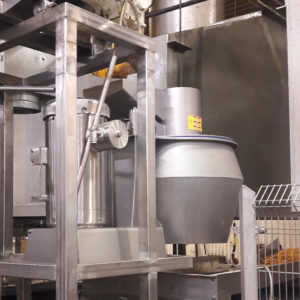New potato slicer further advances chipping capabilities
While the demands of retailers intensify, potato chip makers search for ways to stay ahead of their competition. FAM’s new Centris 400P is a high-capacity centrifugal slicer and shredder designed for the highly competitive potato chip processor looking for better cut quality, longer blade life, increased flexibility and improved speed and capacity.
NECST technology
The innovation is part of the company’s NECST concept, short for Next Evolution in Centrifugal Slicing Technology. Centris 400P was developed by FAM and sister company Stumabo, who makes blades for FAMs machines.

The heart of the machine is the cutting head, the SureSet 16, which has 16 blades in total. Throughout the slicing process, Centris 400P guarantees consistent slice and shred thickness. Its unique design simplifies tasks like changing blades, handling and cleaning.
The slicer is suited to the production of two types of potato chips: batch-processed kettle chips and continuous-process potato chips.
“This high-capacity slicer is very important for the batch processors because they want to deal with high peak capacities,” Van Laer said. “It’s like driving your car over the mountain. You need that extra power, that extra big machine, to deal with high peak capacities.”
For continuous processors, the Centris 400P reduces the number of slicers needed on the line. Bigger processors can use fewer machines, Van Laer said, which is a big advantage when it comes to cutting overhead costs.
Improvements made to the new FAM Centris are focused on bettering overall chip quality. The new cutting head is crucial to this.
“By using a different blade material, we don’t damage all the potato cells within the potato so the starch stays in the potato, which is pure weight and pure money,” he said.
Reducing acrylamide
In big fryers, quality and accuracy mean increased stability. Undamaged potatoes take up less oil during frying as well, which helps lower acrylamide levels — a big concern in some parts of the U.S., particularly in California.
“If your fryer always the same thickness, the same accuracy, you see less burned edges and burned pieces, which means that you have less acrylamide in your product, and you have a more uniform color without changing the color,” Van Laer said.
Blades on the new model last six times longer than they used to. “We go from two hours on the conventional technology, and we run at least 12 hours in continuous lines,” he said. “So, it does a lot for efficiency and they see major savings in terms of quality.”
Typically, batch processors feed at a very high ratio and want to keep production time as short as possible. They also want to reduce the number of slicers they have on the line. Higher capacity machinery like Centris 400P addresses these needs.
Easier to use
Other features include ease of use and cost of ownership. “We see a lot of companies struggling to find highly skilled technicians because they are rare,” Van Laer said. “FAM takes the responsibility away from the operator or technician to maintain the machines. We made it pretty straightforward and easy to use.”
“Basically, everybody can do it and it’s like a set-and-forget system,” he added. “It’s very visual, and you don’t need specific tools for it.”
The machine is also designed to eliminate the need for a trained maintenance crew. The Centris 400P, for example, is belt driven and contains no gearbox, making upkeep and maintenance relatively simple.
Finally, the new Centris 400P offers improved stabilization, which is especially important when cutting potatoes to 1/60,000th of an inch.
“The potato is a complicated product,” said Van Laer. “Accuracy is extremely important.”
Potato quality impacts chip quality, and no two potatoes are created the same. Fresh potatoes coming straight from the field need to be processed differently than blanched or pulsed electric field technology-treated potatoes.
“The good thing is that our cutting head can handle that kind of flexibility,” Van Laer said.
But they don’t leave the complicated questions to the processor. At the start of their relationship, FAM’s application team will evaluate the processor’s products, then train their team to work with the machines. A support crew is available if further questions or issues arise.
American potato chip manufacturer Old Dutch Foods Inc. chose to work with FAM after closely scrutinizing what was available on the market. They were looking to work with a company that could help convert their continuous and batch potato chip slicing lines into a state-of-the-art process.
“We did not rush into a hasty decision,” said Jorn Remmem, director of plant operations and engineering at Old Dutch Foods. “Since it involves investing in capital equipment, we carefully looked into the economic advantages that the investment could bring us. Next to that, strong brand recognition and reputation in the marketplace is very important to us, so quality is our driver.”
When Remmem found FAM, the decision was pretty clear. “For decades there have been no innovations in cutting technology for potato chips,” he said. “The solutions offered by FAM were a breath of fresh air.”
For Old Dutch Foods, the real selling point is the improvement in quality and performance. “There’s a lower scrap rate, less starch loss and nearly no tapered slices,” Remmem said. “Our process is more stable with less variability and better yield. We are able to produce more product at a higher quality.”
— Melanie Epp, contributing writer







